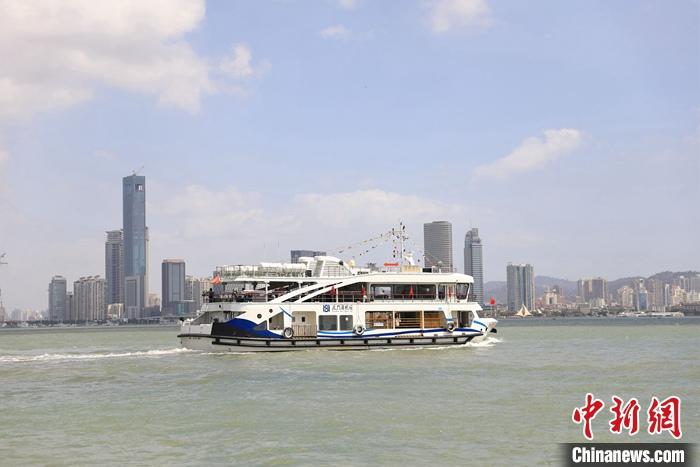The depth of Sino-Brazilian ties
Visitors gather at the exhibition stand of Brazilian food and beverage during the fourth China International Import Expo in Shanghai on Nov 9, 2021. [Photo/VCG]
 (资料图片仅供参考)
(资料图片仅供参考)
President of Brazil Luiz Inacio Lula da Silva concluded his China visit a few days ago. While this was his first China visit during his new presidential term, he had traveled to the Asian country three times during his two previous administrations, from 2003 until 2011. He paid two state visits in 2004 and 2009, respectively, while he also attended the opening ceremony of the Beijing Olympic Games in August 2008. This is indicative of the diachronic importance President Lula attaches to Sino-Brazilian relations, which have thrived in the last 20 years.
World Bank data shows that Brazilian exports to China rose from $4.5 billion in 2003 to $63.3 billion in 2019, the year before the outbreak of the COVID-19 pandemic. In addition, Brazilian imports rose from $2.3 billion in 2003 to $37 billion in 2019. During this timeframe, China became Brazil"s biggest trade partner, beating out close-runners United States and Argentina. According to official statistics from Brazil, Brazilian exports, principally soy, ores, and oil, amounted to $89.7 billion, while imports were worth $60.7 billion last year.
As far as Chinese investments in Brazil are concerned, data showcases the progress. A study by the Brazil China Business Council demonstrates that the annual value of confirmed Chinese investments increased from circa $0.5 billion in 2007 to $7.3 billion in 2019. During this period, its value had been even higher. For example, in 2010, it reached $13.1 billion, and in 2017, it equaled $8.8 billion. The type of investments is multidimensional, covering sectors such as agriculture, electricity generation, information technology, finance, manufacturing, including different products such as machinery and paper, as well as oil and gas extraction and water collection. Although data for 2022 is not yet available, Chinese companies invested $5.9 billion in 2021, an indication of an upward trend after a natural drop in 2020 due to the COVID-19 pandemic.
Against this backdrop, it"s unsurprising that Sino-Brazilian ties further improved during President Lula"s recent visit. Only a few weeks prior, China had resumed imports of Brazilian beef, on top of a yuan clearing arrangement made by the two sides aimed at boosting trade. Now they are both determined to deepen their comprehensive strategic partnership 30 years after its establishment. The relevant joint declaration outlines aspects of their bilateral cooperation, for example, in digital and technological fields as well as in the context of climate change. This cooperation will also lead to more efficient coordination of multilateral formats at the UN, the G20, and the BRICS, among others. Synergies in other formats are also possible. A few months ago, President Lula talked about the likelihood of a free trade agreement between China and MERCOSUR, a union of four states made up of Argentina, Brazil, Paraguay, and Uruguay – at the proposal of Uruguay.
History – even modern history – provides the best way to look at the evolution of Sino-Brazilian relations. While much attention was recently paid to a new program of earth resource satellites (CBERS-6) between the two countries, the first of its kind had already been launched in 1999. Above all, the country"s friendship endures and is outlined at difficult moments. In 2008, Brazil provided timely relief materials in response to the earthquake that hit areas in Sichuan, a gesture that the Chinese people will not forget. Meanwhile, China donated necessary medical equipment to different Brazilian states during the COVID-19 pandemic.
Next year, 2024, marks the 50th anniversary of the establishment of Sino-Brazilian diplomatic relations. The two countries are certainly on a good track to celebrate this anniversary with new bilateral achievements and objectives. There is no better indication than the third state visit of President Lula to China.
George N. Tzogopoulos is a columnist with China.org.cn. For more information please visit:
http://www.china.org.cn/opinion/GeorgeNTzogopoulos.htm
Opinion articles reflect the views of their authors, not necessarily those of China.org.cn.
If you would like to contribute, please contact us at opinion@china.org.cn.
Follow China.org.cn onTwitterandFacebookto join the conversation.ChinaNews App Download标签:
推荐
- The depth of Sino-Brazilian ties
- 环球聚焦:留守儿童
- 他昔日比肩梅西,因一失误葬送国家队前程,如今坚守中甲发挥余热_滚动
- 治疗霉菌最有效的药膏_治疗霉菌最有效的药|今日精选
- 女子眼球被摘除,竟是痔疮惹的祸!|环球精选
- 天天新动态:马普龙vs霸王龙谁厉害_马普龙vs霸王龙
- 研究:美国多个城市正遭受高通胀打击 居民面临沉重生活负担
- 电影《爱很美味》上映 李纯演绎平凡生活中的普通女孩
- 焦点观察:狂降20℃!“倒春寒”要来了!
- 通州区气象台发布大风蓝色预警【IV/一般】
- 开封市尉氏县门楼任乡:安全无小事,平安记心中
- 全球新动态:白酒概念板块跌0.46% 青海春天涨4.49%居首
- 房地产开发板块跌1.51% 万业企业涨7.36%居首 全球百事通
- 今日精选:英诺魮_关于英诺魮的简介
- 绿茵生态:子公司休闲旅游项目一期已建成落地|热门
- 中国星辰丨从无到有,中国载人航天如何大胆跨越?|天天观热点
- 贵州燃气:股东贵阳工投累计质押约1.89亿股 占其所持公司股份46.28%-世界观速讯
- 2023杭州西湖景区五一外地车限行吗-焦点短讯
- 环球热议:需求扩大、供给恢复、预期改善 一季度我国经济发展实现良好开局
- 以工业思维念“农业经”
- 乘储能爆发东风!储能逆变器市场前景广阔_环球讯息
- 【环球播资讯】6月初好运不断,这3大星座得财神关照,迎来横财无数!
- 爱国主义手抄报资料内容_爱国主义手抄报资料
- 扎根瑶寨 守护希望(追梦路上)
- 世界快资讯:旅泰大熊猫林惠鼻部出血!官方回应:已开展会诊
- 三门峡市湖滨区财政局:开展全民国家安全教育日宣传活动
- 全球微头条丨涂料起泡怎么处理
- 今日热搜:一文一物|丝绸之路上的彩陶文化
- 爱国者2TB SSD售价仅579元 速度可达7450MB/s
- 842套!北京海淀又一批公租房开始登记
- 一季度GDP数据超预期!这个被“错杀”的方向机会来了
- 题记小标题作文大全 小标题作文大全
- 人力资源服务板块股票有哪些?(2023/4/19)-天天速递
- 英语高级口译岗位资格证书实考试卷解析4_关于英语高级口译岗位资格证书实考试卷解析4的简介 当前热闻
- 天天即时:晋江:闪电338次 日降雨量123毫米 险些打破50年纪录
- 以山水书院为主题 高颜值“大零号湾图书馆”本周六开馆-世界新消息
- 相约通道合拢宴①丨刨汤肉:童年“将伯汤”的快乐 用味道铭记
- 今日热文:桂平市气象台发布大风蓝色预警信号【IV级/一般】【2023-04-19】
- 关于元旦节的手抄报_庆元旦,迎新年。魏县第十二中学开展2023年元旦手抄报展示活动_环球今日讯
- 官方:福克斯当选NBA年度最佳关键球员
- 环球视讯!文明理性消费 保护合法权益
- 中国电信:4月18日融资买入4.13亿元,融资融券余额13.74亿元|世界快看点
- 沙县区气象台解除暴雨橙色预警【Ⅱ级/严重】|天天热头条
- 当前速读:嫡女复仇之冥王宠妃
- 当前讯息:国海证券给予隆盛科技买入评级 2022年报及2023年一季报点评:销售承压逐季消退 马达铁芯有望长期受益
- 4月18日基金净值:博时价值增长混合最新净值1.04,跌0.19%
- 快讯2023-04-19 01:18:57
- 钻石玫瑰一年开几次花 钻石玫瑰每年哪时候开花呢
- 掌上《南安新闻》2023年4月18日 全球独家
- 诗经国风的篇目_诗经国风有多少篇
- 精彩看点:控制面板不见了怎么办_Win11找不到显卡控制面板怎么办?
- 轻松一刻:第一次去按摩,需要注意些什么吗?-每日速讯
- 曝追梦脚踝酸痛接受X检查:晒小萨抱腿照树受害者形象 避免禁赛吗 焦点报道
- 国网湖北电力今年将新建充电桩2万台!中心城区2公里找到桩 远城区5公里充上电
- 弈秋败一_请问 哪位能帮我找到孟子 弈秋败弈 原文
- 近期评分榜TOP10!《长月烬明》6.2分没前十,《招惹》7.1分第六,冠军是8.2分
- 全球快播:媚道精油
- 每日焦点!济南市莱芜区大王庄镇邮编_山东济南市莱芜区邮编
- 解聘证明可以领失业金_解聘证明_速看料
- 手干裂口子怎么办_手指开裂是怎么回事怎么处理 重点聚焦
- 全球热议:infp_inf
- 全球头条:严打“黑车” 西安经开区多部门联动保障北客站交通秩序稳定
- 龙之谷弓箭手名字_龙之谷弓箭手
- 天天简讯:杨德龙:我国一季度多项经济数据超预期 经济复苏势头进一步确立
- 全球央行大举购金 释放什么信号?
- 环球热文:中级注册安全工程师专业如何选择?
- 国林科技:公司光伏用高浓度臭氧水机主要用于生产HJT异质结类型电池板
- 天天百事通!库克亲自出席!苹果印度首家Apple Store开业:太阳能电池板供电
- 特斯拉上海工厂被爆克扣员工绩效马斯克:已知晓,将调查
- 全新smart精灵#3亮相 6月国内上市并同步开启交付
- 世界微速讯:拆违第一线|100天逾55000平方米!徐汇的“头丝”更“清桑”了
- 中国商旅市场2023年预计恢复至89%,超九成差旅客期待“混合式商旅”|焦点速看
- 新开工项目31个,较去年同期增加15个!青岛一季度停车设施建设持续上新 焦点播报
- 马斯克称将开发不会消灭人类的AI,呼吁建立人工智能监管机构
- 潘多拉归来烈焰女巫阵容搭配攻略
- 海信空气能实力亮相中国北方清洁供暖峰会
- 网易123邮箱登录入口_网易123邮箱登录
- 微速讯:徐州密集资料柜行情走势
- 美国枪支问题积重难返,背后利益集团难辞其咎
- 跨区域授信、手续费减免……京津冀地区新市民金融服务加码协同联动|全球要闻
- 真相大白!5人被查,幕后大鱼落马,蔡振华尘埃落定,范志毅高升
- 博物馆、图书馆、文化馆将延长夜游时间,你支持吗?
- 世界视讯!美国63岁女作家:“我不想失去我的TikTok”
- 三部门明确对广交会进口展品实行税收优惠 焦点速讯
- 上海公积金热线12329工作时间_上海12329公积金官网
- 全球观察:7999元质价比旗舰影游大屏电视 Vidda X85 Pro正式发布
- 天天快资讯丨鹭燕医药董秘回复:公司主营业务为医药分销与零售、中药饮片生产与销售;以纯销为主要经营模式
- 我国科技企业积极“出海”中东
- ROG官宣品牌代言人 携手郭帆导演致敬创造者 世界观速讯
- 环球短讯!留在大山深处 坚守三尺讲台(讲述·一辈子一件事)
- 凌晨3点欧冠1/4决赛生死战:皇马vs切尔西三大看点,附比分预测
- 每日热闻!太阳能的应用论文_太阳能的应用
- “四个制”工作方法提升群众满意度-焦点快报
- 宾至如归下一句是什么_宾至如归 天天报道
- 房屋拆迁主房和附房补偿标准是怎样的?
- 第五届“守护幸福河湖”短视频征集活动在川启动_微速讯
- 环球热推荐:起亚的“卑微”,从赛图斯预售9.19万开始
- 浙江金华市武义突发大火 被困人员仍在搜救 全球视讯
- 鄂电联会员单位“培训季”首期在汉举行 环球热头条
- 评论1+1:篮协严处“消极比赛”,竞技场不能藏污纳垢
X 关闭
行业规章
X 关闭


